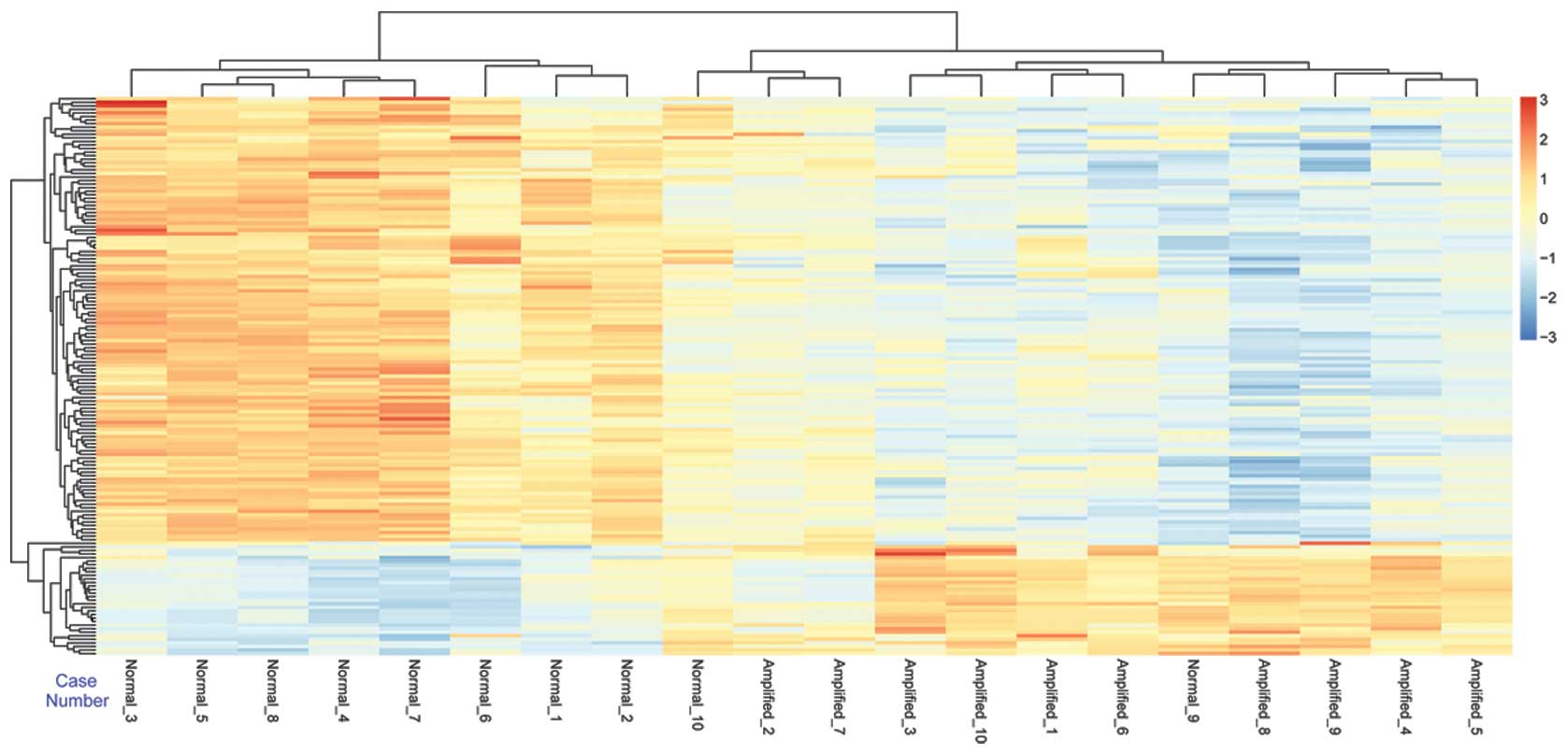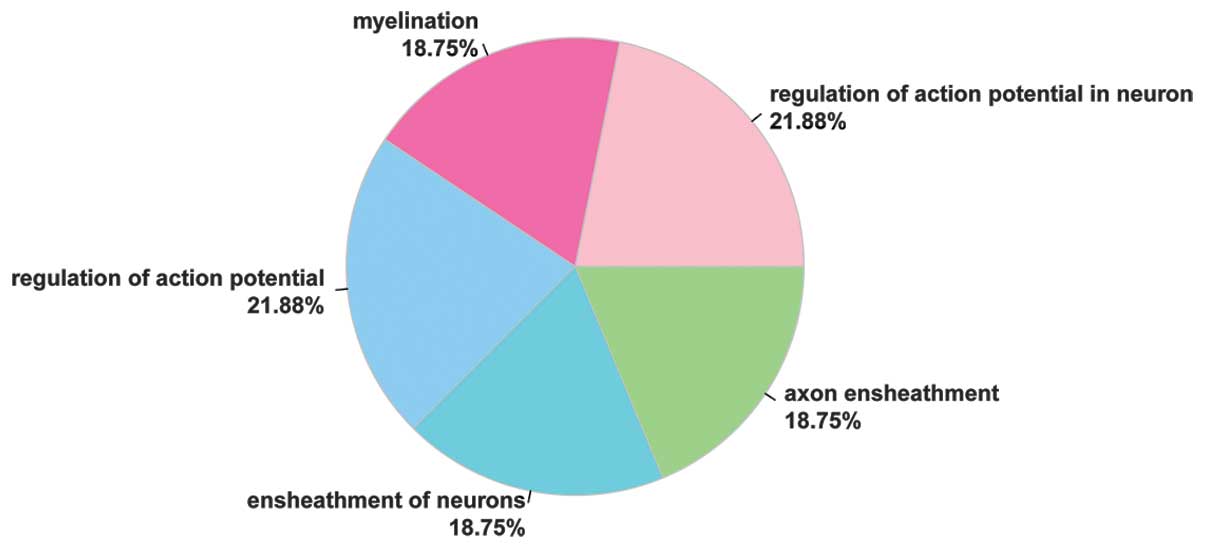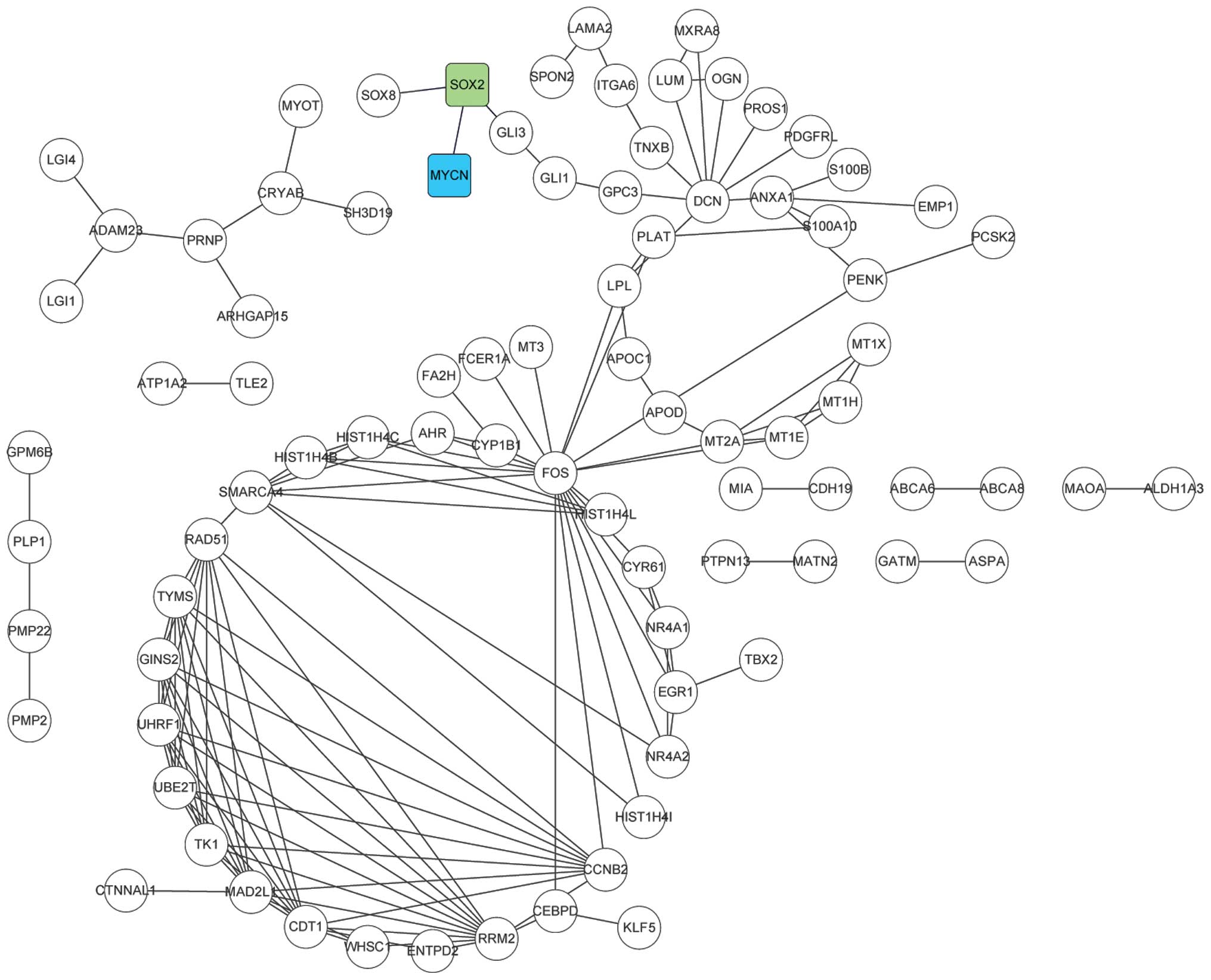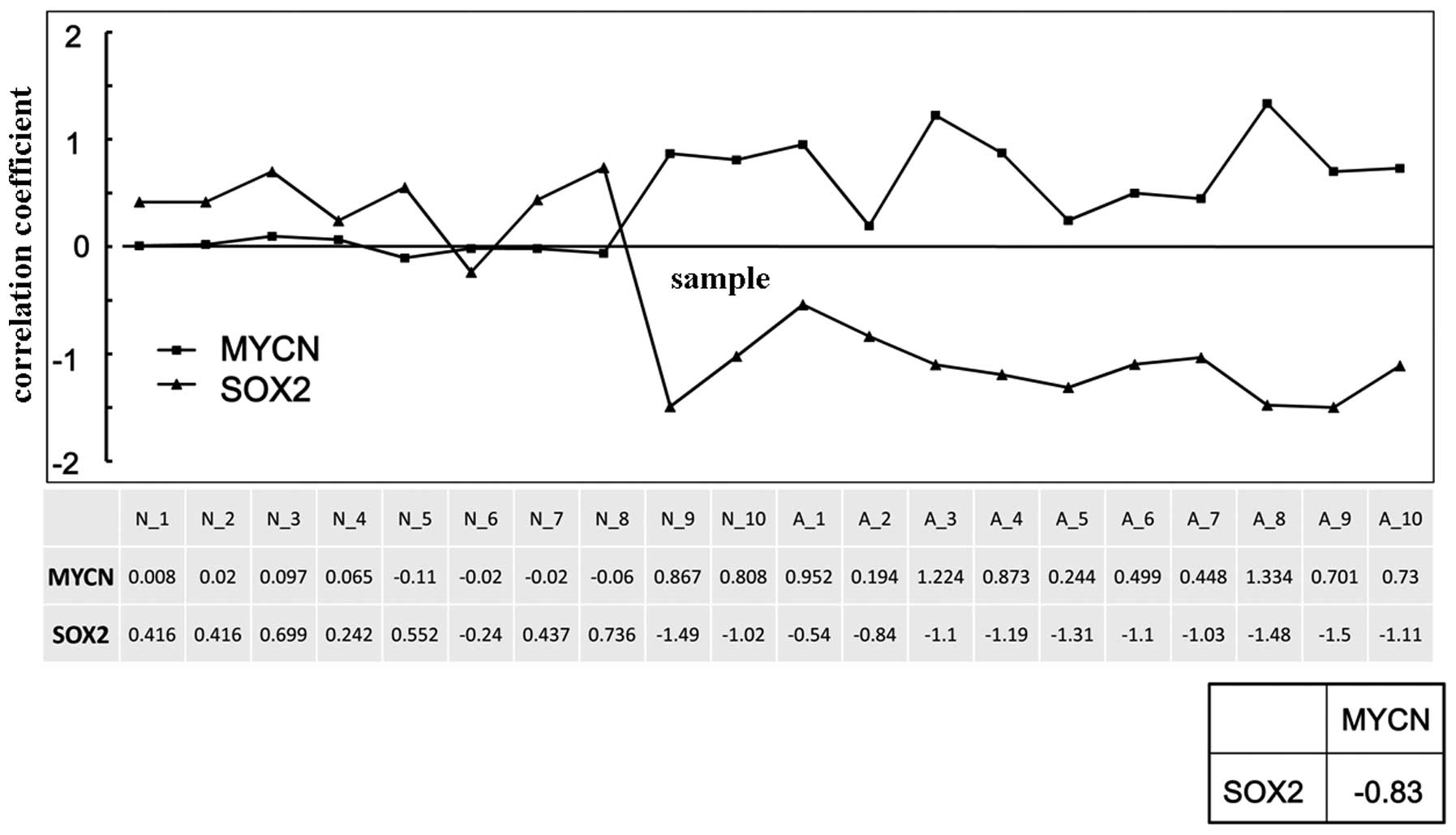Microarray data analysis of neuroblastoma: Expression of SOX2 downregulates the expression of MYCN
- Authors:
- Published online on: September 10, 2015 https://doi.org/10.3892/mmr.2015.4311
- Pages: 6867-6872
Abstract
Introduction
Neuroblastoma (NB) is a cancer of the peripheral sympathetic neurons, which occurs during childhood, and the percentage of NB of all pediatric oncology-associated mortality is ~10% worldwide (1). NB predominately occurs in young children, of which the average age is 17 months (2) NB derives from undifferentiated neural crest cells and metastasizes to other organs (3). Patients with NB have poor prognosis with a 5-year survival rate of no more than 30% (4).
With the development of the field of biology, increasing numbers of markers correlated with NB have been identified. MYCN is a well-known prognostic marker of NB (5), and MYCN amplification is the most significant molecular marker of risk in NB (6). Tang et al demonstrated that patients with NB exhibiting low expression levels of MYCN and TrkA have a 5-year survival rate of 63.7%, whereas the 5-year survival rate of patients with high expression levels of the two is 88.1% (7). In addition, the alternative TrkAIII splice variant is involved in the pathogenesis of advanced stage human NB through microtubules, which are involved in the promotion and maintenance of NB cells (8). In addition to these reports, NCYM has been observed to act as a cis-antisense gene of MYCN, and contributes to the stabilization of MYCN in human NB by inhibiting GSK3β (9). NCYM, co-amplified with MYCN, is involved in the pathogenesis of NB (10). Although several studies have reported that MYCN is key in the pathogenesis of NB, the genes correlated with MYCN amplification remain to be fully elucidated. Therefore, the present study aimed to examine the molecular mechanism of MYCN amplification in NB.
Wu et al analyzed expression profiles using Ingenuity Pathway Analysis, and found that the aryl hydrocarbon receptor downregulates the expression of MYCN through the mediation of E2F1 in the protein-protein interaction (PPI) network, and further confirmed that the aryl hydrocarbon receptor regulates the activity of the MYCN promoter and results in the downregulated expression of MYCN (11). To identify more genes correlated with MYCN in the present study, the determination of differentially expressed genes (DEGs) between NB cell lines exhibiting MYCN amplification (MYCN amplification group) and NB cell lines with a normal MYCN copy number (control group) were identified. Hierarchical clustering and Gene Ontology (GO) analysis were performed for these DEGs, and a protein-protein interaction (PPI) network was constructed for the DEGs to identify the key genes associated with MYCN. Kyoto Encyclopedia of Genes and Genomes (KEGG) pathway enrichment analysis was also performed for the DEGs in PPI network. The correlation of MYCN and the key gene associated with to MYCN was determined using Pearson's correlation coefficient, in order to investigate whether their association was synergistic or antagonistic.
Materials and methods
Microarray data
Microarray data (accession. no. GSE53371) were downloaded from the Gene Expression Omnibus (GEO, http://www.ncbi.nlm.nih.gov/geo/) (11). The microarray platform of GSE53371 was GPL887 Agilent-012097 Human 1A Microarray (V2) G4110B (Feature Number version; Agilent Technologies, Inc., Santa Clara, CA, USA). A total of 20 samples were available, which included 10 NB cell lines with MYCN amplification and 10 NB cell lines with a normal MYCN copy number.
Data preprocessing and identification of DEGs
Normalization of the microarray data were performed using a median normalization method (12). The DEGs were identified using the Linear Models for Microarray Data (Limma) package (13). The raw P-value was adjusted into a false discovery rate (FDR) using the Benjamini & Hochberg method (14,15). The genes with an FDR <0.05 and |log2FC (fold change)|>1 were considered significantly different between the MYCN amplification group and the control group.
Hierarchical clustering analysis of DEGs
Based on the Euclidean distance, which is the actual distance between two points that may be calculated using the Pythagorean formula, hierarchical clustering analysis (16) was performed to evaluate the sample specificity. In the hierarchical clustering analysis, the expression value of the DEGs were extracted, and subsequent analysis was performed of the DEGs using the Pheatmap package in R language (http://cran.r-project.org/web/packages/pheatmap/index.html) (16,17).
Functional enrichment analysis of DEGs
The Database for Annotation, Visualization and Integrated Discovery (DAVID) is a comprehensive functional annotation tool (18). Gene Ontology (GO) analysis was performed for the DEGs using the DAVID database (http://david.abcc.ncifcrf.gov/). The raw P-value was adjusted into the FDR using Benjamini & Hochberg's method and an FDR <0.05 was selected as the cut-off criterion.
Construction of the PPI network
The Search Tool for the Retrieval of Interacting Genes (STRING) database is used to collect and predict PPI associations (19). In the present study, a PPI network was constructed for the DEGs using STRING, and a confidence score >0.4 was selected as the cut-off criterion. Subsequent visualization of the PPI network was performed using Cytoscape (http://cytoscape.org/) (20).
Pathway analysis of DEGs in the PPI network
The WEB-based GEne SeT AnaLysis Toolkit (WebGestalt) aims to examine large sets of genes, and is used for functional enrichment analysis, including GO enrichment, pathway enrichment and transcription factor analysis, by integrating functional categories (21,22). KEGG (http://www.genome.ad.jp/kegg) pathway enrichment analysis was performed for the DEGs in the PPI network using WebGestalt, and P<0.05 was selected as the cut-off criterion.
Correlation analysis
Based on the PPI network, the expression values of the genes correlated directly with MYCN were extracted, and correlation analysis was performed using the expression values of the genes. For this correlation analysis, the correlation of MYCN and the key gene associated with MYCN was determined using Pearson's correlation coefficient (23) with SPSS 13.0 (SPSS Inc., Chicago, IL, USA).
Results
Identification of DEGs
In total, 172 DEGs between the MYCN amplification group and the control group were identified, which included 137 downregulated DEGs and 35 upregulated DEGs.
Hierarchical clustering analysis of the DEGs
Following hierarchical clustering analysis, there were two distinct gene clusters identified, including the MYCN amplification cluster and control cluster (Fig. 1). These results suggested that there were two different gene expression patterns with marked color differences, which were available for use to distinguish between the MYCN amplification samples and the control samples.
GO enrichment analysis of the DEGs
GO enrichment analysis revealed that the five enriched terms were as follows: Regulation of action potential in neuron (P=1.24E-05), myelination (P=2.95E-05), regulation of action potential (P=4.71E-05), ensheathment of neurons (P=4.85E-05) and axon ensheathment (P=4.85E-05), as listed in Table I. The KCNMB4, PLP1, CLDN1, LGI4, MAL, PMP22 and GAL3ST1 genes were involved in the regulation of action potential in neuron biological process, and the percentage of the genes enriched in this term was 21.88% (Fig. 2).
PPI network analysis of DEGs and pathway analysis
Analysis of the PPI network revealed that there were 85 nodes and 142 gene links, and SOX2 was identified as the key gene correlated directly with MYCN (Fig. 3).
KEGG pathway enrichment analysis of the DEGs in the PPI network indicated that the ASPA, MAOA and ALDH1A3 genes were involved in the histidine metabolism pathway (P=0.012376), and the LAMA2, FOS, ITGA6, GLI3, GLI1 and RAD51 genes were involved in the extracellular matrix (ECM)-receptor interaction pathway (P=0.040716; Table II).
Table IITop two most enriched KEGG pathways of the differentially expressed genes in the protein-protein interaction network. |
Correlation analysis of genes
Correlation analysis indicated that the expression of SOX2 was inversely correlated with the expression of MYCN in the NB cell lines, and the correlation coefficient of SOX2 and MYCN was −0.83 (Fig. 4).
Discussion
In the present study, 172 DEGs between the MYCN amplification group and control group were identified, which included 137 downregulated and 35 upregulated DEGs. Functional enrichment analysis indicated that the KCNMB4 gene was involved in the regulation of action potential in neuron pethway, and the FOS, GLI3 and GLI1 genes were involved in the ECM-receptor interaction pathway. Correlation analysis demonstrated that the expression of SOX2 was inversely correlated with the expression of MYCN in the NB cell lines.
Neurons encode and convey information by generating action potentials (24). According to a previous report by Hall et al, the expression of specific Kv3.1 glycoprotein, which is a voltage-gated potassium (Kv) channel, has an impact on the wave form of action potentials and N-glycans associated with the Kv3.1 protein affect the migratory rate of The NB cell (25). In addition, Leung et al demonstrated that the voltage-gated Kv channel has an effect on cAMP-stimulated neuritogenesis in mouse NB N2A cells (26). These findings suggest that the voltage-gated Kv channels are important in the development of NB through the modulation of action potentials. Large-conductance Ca2+-activated K+ (BK) channels contribute to the excitability of neurons (27). The two subunits of BKβ are BKβ3 (KCNMB3) and BKβ4 (KCNMB4) (28). Therefore, KCNMB4 may be involved in the pathogenesis of NB through the voltage-gated Kv channel. In the present study, KCNMB4 was involved in the regulation of action potential in neuron biological process. Based on these findings, it was hypothesized that KCNMB4 is involved in the development of NB by the regulation of action potentials in neurons.
SOX2, located in chromosome 3q26.33, is a transcription factor which is involved in the regulation of stem cell properties (29,30). Previously, it has been reported that neural stem cell-like cells are isolated from certain types of neural cancer, including glioblastoma, medulloblastoma and NB (31,32). In addition, Das et al demonstrated that SOX2 is involved in the maintenance of undifferentiated stem cells by the regulation of all-trans retinoic acid, which induces the differentiation of NB cells. Furthermore, miR-340 has been found to be involved in the pathogenesis of NB by mediating the expression of SOX2 (33). Wang et al found that FoxM1 is involved in the tumorigenicity of aggressive NB cells by activating the expression of SOX2 (34). According to a report by Yang et al, the expression of OCT4 and SOX2 are involved in the progression of NB (35). These results indicate that SOX2 is important in the pathogenesis of NB. The results of the present study, which revealed that the expression of SOX2 was directly correlated with the expression of MYCN, were consistent with previous findings. Therefore, SOX2 may be involved in the pathology of NB through the regulation of MYCN.
In the present study, PPI network analysis indicated that GLI1 regulated SOX2 by the mediation of GLI3, and FOX also regulated the expression of SOX2 by the mediation of DCN. GLI1 and GLI3 are mediators of the SHH pathway, which has an effect on the early development of the central nervous system (36). In addition, SHH-GLI1 is involved in the self-renewal of cancer stem cells (37). Furthermore, Shahi et al reported that the expression of SMO and GLI3 are partially correlated in NB (38). These results suggest that GLI1 and GLI3 may be involved in the development of NB by the mediation of SOX2. In addition, FOX proteins are a conserved transcriptional regulator superfamily, and FOX family transcription factors are key in the progression of cancer (39). In NB, FOXR1, fused to MLL or PAFAH1B due to interstitial deletions, function as oncogenes (40). Santo et al demonstrated that events of intra-chromosomal deletion/fusion at 11q23 activate the expression of FOXR1 in NB (41). This suggested that FOX may also be involved in the pathogenesis of NB by the regulation of SOX2. According to these findings, the present study hypothesized that FOS, GLI3 and GLI1 may regulate the expression of MYCN by the mediation of SOX2. Although the findings of the present study were consistent with previous observations that the FOS, GLI3 and GLI1 genes are involved in the pathogenesis of NB, the present study revealed that the FOS, GLI3 and GLI1 genes were involved in the ECM-receptor interaction pathway. Therefore, FOS, GLI3 and GLI1 may be involved in the ECM-receptor interaction pathway to contribute to the development of NB.
In conclusion, the present study identified 172 DEGs between the MYCN amplification group and the control group, including 137 downregulated and 35 upregulated DEGs. KCNMB4 may contribute to the development of NB by the regulation of action potentials in neurons. FOS, GLI3 and GLI1 may be involved in the pathogenesis of NB by the regulation of SOX2, the expression of which was inversely correlated to the expression of MYCN in the NB cell lines. These findings have provided a novel opportunity to investigate the pathogenesis of NB, however, these results require confirmation by further investigations.
References
|
Wang K, Diskin SJ, Zhang H, Attiyeh EF, Winter C, Hou C, Schnepp RW, Diamond M, Bosse K, Mayes PA, et al: Integrative genomics identifies LMO1 as a neuroblastoma oncogene. Nature. 469:216–220. 2011. View Article : Google Scholar | |
|
Maris JM: Recent advances in neuroblastoma. N Engl J Med. 362:2202–2211. 2010. View Article : Google Scholar : PubMed/NCBI | |
|
Huang M and Weiss WA: Neuroblastoma and MYCN. Cold Spring Harb Perspect Med. 3:a0144152013. View Article : Google Scholar : PubMed/NCBI | |
|
Nishihira H, Toyoda Y, Tanaka Y, Ijiri R, Aida N, Takeuchi M, Ohnuma K, Kigasawa H, Kato K and Nishi T: Natural course of neuroblastoma detected by mass screening: S 5-year prospective study at a single institution. J Clin Oncol. 18:3012–3017. 2000.PubMed/NCBI | |
|
De Bernardi B, Gerrard M, Boni L, Rubie H, Cañete A, Di Cataldo A, Castel V, Forjaz de Lacerda A, Ladenstein R, Ruud E, et al: Excellent outcome with reduced treatment for infants with disseminated neuroblastoma without MYCN gene amplification. J Clin Oncol. 27:1034–1040. 2009. View Article : Google Scholar : PubMed/NCBI | |
|
Kaneko M, Tsuchida Y, Mugishima H, Ohnuma N, Yamamoto K, Kawa K, Iwafuchi M, Sawada T and Suita S: Intensified chemotherapy increases the survival rates in patients with stage 4 neuroblastoma with MYCN amplification. J Pediatr Hematol Oncol. 24:613–621. 2002. View Article : Google Scholar : PubMed/NCBI | |
|
Tang XX, Zhao H, Kung B, Kim DY, Hicks SL, Cohn SL, Cheung NK, Seeger RC, Evans AE and Ikegaki N: The MYCN enigma: Significance of MYCN expression in neuroblastoma. Cancer Res. 66:2826–2833. 2006. View Article : Google Scholar : PubMed/NCBI | |
|
Farina AR, Di Ianni N, Cappabianca L, Ruggeri P, Ragone M, Ianni G, Gulino A and Mackay AR: TrkAIII promotes micro-tubule nucleation and assembly at the centrosome in SH-SY5Y neuroblastoma cells, contributing to an undifferentiated anaplastic phenotype. Biomed Res Int. 2013:7401872013. View Article : Google Scholar | |
|
Suenaga Y, Islam SM, Alagu J, Kaneko Y, Kato M, Tanaka Y, Kawana H, Hossain S, Matsumoto D, Yamamoto M, et al: NCYM, a Cis-antisense gene of MYCN, encodes a de novo evolved protein that inhibits GSK3β resulting in the stabilization of MYCN in human neuroblastomas. PLoS Genet. 10:e10039962014. View Article : Google Scholar | |
|
Alderton GK: Neuroblastoma: A new gene that promotes NMYC activity. Nature Reviews Cancer. 14:155. 2014. | |
|
Wu PY, Liao YF, Juan HF, Huang HC, Wang BJ, Lu YL, Yu IS, Shih YY, Jeng YM, Hsu WM and Lee H: Aryl hydrocarbon receptor downregulates MYCN expression and promotes cell differentiation of neuroblastoma. PLoS One. 9:e887952014. View Article : Google Scholar : PubMed/NCBI | |
|
Fujita A, Sato JR, Rodrigues Lde O, Ferreira CE and Sogayar MC: Evaluating different methods of microarray data normalization. BMC Bioinformatics. 7:4692006. View Article : Google Scholar : PubMed/NCBI | |
|
Smyth GK: Limma: Linear models for microarray data. Bioinformatics and computational biology solutions using R and Bioconductor. Springer; pp. 397–420. 2005, View Article : Google Scholar | |
|
Benjamini Y: Discovering the false discovery rate. J R Stat Soc Series B Stat Methodol. 72:405–416. 2010. View Article : Google Scholar | |
|
Benjamini Y and Hochberg Y: Controlling the false discovery rate: a practical and powerful approach to multiple testing. J R Stat Soc Series B Stat Methodol. 289–300. 1995. | |
|
Szekely GJ and Rizzo ML: Hierarchical clustering via joint between-within distances: Extending Ward's minimum variance method. Journal of Classification. 22:151–183. 2005. View Article : Google Scholar | |
|
Deza MM and Deza E: Encyclopedia of distances. Springer; 2009, View Article : Google Scholar | |
|
Jiao X, Sherman BT, Huang da W, Stephens R, Baseler MW, Lane HC and Lempicki RA: DAVID-WS: A stateful web service to facilitate gene/protein list analysis. Bioinformatics. 28:1805–1806. 2012. View Article : Google Scholar : PubMed/NCBI | |
|
Szklarczyk D, Franceschini A, Kuhn M, Simonovic M, Roth A, Minguez P, Doerks T, Stark M, Muller J, Bork P, et al: The STRING database in 2011: Functional interaction networks of proteins, globally integrated and scored. Nucleic Acids Res. 39:D561–D568. 2011. View Article : Google Scholar : | |
|
Smoot ME, Ono K, Ruscheinski J, Wang PL and Ideker T: Cytoscape 2.8: New features for data integration and network visualization. Bioinformatics. 27:431–432. 2011. View Article : Google Scholar : | |
|
Zhang B, Kirov S and Snoddy J: WebGestalt: An integrated system for exploring gene sets in various biological contexts. Nucleic Acids Res. 33:W741–W748. 2005. View Article : Google Scholar : PubMed/NCBI | |
|
Wang J, Duncan D, Shi Z and Zhang B: WEB-based GEne SeT AnaLysis Toolkit (WebGestalt): Update 2013. Nucleic Acids Res. 41:W77–W83. 2013. View Article : Google Scholar : PubMed/NCBI | |
|
Bieniasz M, Oszajca K, Eusebio M, Kordiak J, Bartkowiak J and Szemraj J: The positive correlation between gene expression of the two angiogenic factors: VEGF and BMP-2 in lung cancer patients. Lung Cancer. 66:319–326. 2009. View Article : Google Scholar : PubMed/NCBI | |
|
Bean BP: The action potential in mammalian central neurons. Nat Rev Neurosci. 8:451–465. 2007. View Article : Google Scholar : PubMed/NCBI | |
|
Hall MK, Cartwright TA, Fleming CM and Schwalbe RA: Importance of glycosylation on function of a potassium channel in neuroblastoma cells. PLoS One. 6:e193172011. View Article : Google Scholar : PubMed/NCBI | |
|
Leung YM, Huang CF, Chao CC, Lu DY, Kuo CS, Cheng TH, Chang LY and Chou CH: Voltage-gated K+ channels play a role in cAMP-stimulated neuritogenesis in mouse neuroblastoma N2A cells. J Cell Physiol. 226:1090–1098. 2011. View Article : Google Scholar | |
|
Manna I, Labate A, Mumoli L, Ferlazzo E, Aguglia U, Quattrone A and Gambardella A: Failure to confirm association of a polymorphism in KCNMB4 gene with mesial temporal lobe epilepsy. Epilepsy Res. 106:284–287. 2013. View Article : Google Scholar : PubMed/NCBI | |
|
Behrens R, Nolting A, Reimann F, Schwarz M, Waldschütz R and Pongs O: HKCNMB3 and hKCNMB4, cloning and characterization of two members of the large-conductance calcium-activated potassium channel beta subunit family. FEBS Lett. 474:99–106. 2000. View Article : Google Scholar : PubMed/NCBI | |
|
Gómez-Mateo Mdel C, Piqueras M, Påhlman S, Noguera R and Navarro S: Prognostic value of SOX2 expression in neu roblastoma. Genes Chromosomes Cancer. 50:374–377. 2011. View Article : Google Scholar | |
|
Pietras A, Gisselsson D, Ora I, Noguera R, Beckman S, Navarro S and Påhlman S: High levels of HIF-2alpha highlight an immature neural crest-like neuroblastoma cell cohort located in a perivascular niche. J Pathol. 214:482–488. 2008. View Article : Google Scholar : PubMed/NCBI | |
|
Melone MA, Giuliano M, Squillaro T, Alessio N, Casale F, Mattioli E, Cipollaro M, Giordano A and Galderisi U: Genes involved in regulation of stem cell properties: Studies on their expression in a small cohort of neuroblastoma patients. Cancer Biol Ther. 8:1300–1306. 2009. View Article : Google Scholar : PubMed/NCBI | |
|
Hansford LM, McKee AE, Zhang L, George RE, Gerstle JT, Thorner PS, Smith KM, Look AT, Yeger H, Miller FD, et al: Neuroblastoma cells isolated from bone marrow metastases contain a naturally enriched tumor-initiating cell. Cancer Res. 67:11234–11243. 2007. View Article : Google Scholar : PubMed/NCBI | |
|
Das S, Bryan K, Buckley PG, Piskareva O, Bray IM, Foley N, Ryan J, Lynch J, Creevey L, Fay J, et al: Modulation of neuroblastoma disease pathogenesis by an extensive network of epigenetically regulated microRNAs. Oncogene. 32:2927–2936. 2013. View Article : Google Scholar | |
|
Wang Z, Park HJ, Carr JR, Chen YJ, Zheng Y, Li J, Tyner AL, Costa RH, Bagchi S and Raychaudhuri P: FoxM1 in tumorigenicity of the neuroblastoma cells and renewal of the neural progenitors. Cancer Res. 71:4292–4302. 2011. View Article : Google Scholar : PubMed/NCBI | |
|
Yang S, Zheng J, Ma Y, Zhu H, Xu T, Dong K and Xiao X: Oct4 and Sox2 are overexpressed in human neuroblastoma and inhibited by chemotherapy. Oncol Rep. 28:186–192. 2012.PubMed/NCBI | |
|
Zhu H and Lo HW: The human glioma-associated oncogene homolog 1 (Gli1) family of transcription factors in gene regulation and diseases. Curr Genomics. 11:238–245. 2010. View Article : Google Scholar : PubMed/NCBI | |
|
Clement V, Sanchez P, de Tribolet N, Radovanovic I and Ruiz i Altaba A: HEDGEHOG-GLI1 signaling regulates human glioma growth, cancer stem cell self-renewal and tumorigenicity. Curr Biol. 17:165–172. 2007. View Article : Google Scholar : PubMed/NCBI | |
|
Shahi MH, Lorente A and Castresana JS: Hedgehog signalling in medulloblastoma, glioblastoma and neuroblastoma. Oncol Rep. 19:681–688. 2008.PubMed/NCBI | |
|
Myatt SS and Lam EWF: The emerging roles of forkhead box (Fox) proteins in cancer. Nat Rev Cancer. 7:847–859. 2007. View Article : Google Scholar : PubMed/NCBI | |
|
Katoh M, Igarashi M, Fukuda H and Nakagama H: Cancer genetics and genomics of human FOX family genes. Cancer Lett. 328:198–206. 2013. View Article : Google Scholar | |
|
Santo EE, Ebus ME, Koster J, Schulte JH, Lakeman A, van Sluis P, Vermeulen J, Gisselsson D, Øra I, Lindner S, et al: Oncogenic activation of FOXR1 by 11q23 intrachromosomal deletion-fusions in neuroblastoma. Oncogene. 31:1571–1581. 2012. View Article : Google Scholar |













